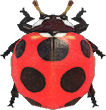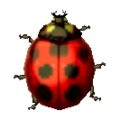Ladybug
| ||||||||
 | ||||||||
| Real-world info | ||||||||
|---|---|---|---|---|---|---|---|---|
| Name: Coccinella septempunctata Family: Coccinellidae (Ladybugs) | ||||||||
| Main appearances | ||||||||
|
| ||||||||
| Other appearances | ||||||||
Names in other languages
テントウムシ
瓢虫 Coccinelle Mariquita Coccinella Божья коровка
무당벌레 瓢蟲 Coccinelle Catarina Marienkäfer Lieveheersbeestje | ||||||||
The Ladybug (known as the Spotted Ladybug in Animal Crossing) is a bug in the Animal Crossing series. It is a small, black and red beetle that appears on flowers throughout spring and summer. They are common and worth 200 Bells. They will fly away if players approach them too quickly or walk onto the flower they are crawling on. Their buzzing when they fly is quiet.
Catch details
In Animal Crossing
In Wild World
In City Folk
| Description | Also called ladybirds or lady beetles, these help gardens by controlling pests. |
|---|---|
| Time of year | Mar – Jun; Sep – Oct |
| Time of day | 8 AM – 5 PM |
| Peak times | Mar – May |
| Location | On flowers |
| Bug size | Unknown |
| Rarity | Uncommon |
| Selling price | |
| Furniture size |
In New Leaf
| Time of year | Mar – Jun; Oct |
|---|---|
| Time of day | 8 AM - 5 PM |
| Peak times | Mar – May |
| Location | On flowers |
| Size | Unknown |
| Rarity | Common |
| Selling price | |
| Furniture size |
In New Horizons
| Time of year | North: Mar – Jun; Oct South: Apr; Sep – Dec |
|---|---|
| Time of day | 8 AM – 5 PM |
| Location | On flowers |
| Weather | Any except rain |
| Spawn requirement | Appears from the start of the game |
| Selling prices | |
| Furniture size |
Donating to the museum
As with all other fish and insects in the Animal Crossing series, the Ladybug can be donated to the museum by talking to Blathers the curator, who will also give information upon donation.
In Animal Crossing
Blathers, the curator of the museum, says the following when it is handed to him for donation:
The Spotted Ladybug can be found nestled among the flowers in the center of the insect room after donation.
In Wild World
After donation the Ladybug appears in the museums first insect room, on the left side, on the flowers between the palm trees.
In City Folk
The following information is what Blathers says to the player upon donation of the Ladybug:
After donation, the Ladybug can be found sitting on a flower on the lower terrace of the insect room.
In New Leaf
Upon being donated, the Ladybug can be found in the first room of the bug exhibit, on the red flower on the right side.
In New Horizons
Gallery
Real-world information
Frequently referred as a "ladybug" in the U.S. or a "ladybird" in Britain, ladybird beetles contain 5,000 species of Coccinellidae, worldwide. Species can vary from number of spots to body shape, and even color. In fact, tan varieties of ladybird beetles exist. The ladybird beetle represented in the Animal Crossing series is Coccinella septempunctata, the Seven-spot ladybird beetle. It lives almost anywhere where there are aphids, its main prey, to eat. Ladybird beetles are considered by many to be beneficial to plants due to their eating habits- aphids themselves eat plants, so by introducing ladybird beetles, plants can be protected. The seven-spot itself was introduced to North America in this manner.
The yellow fluid that Blathers refers to is called reflex blood; the ladybird beetle breaks its own joints to induce this bleeding. The blood has an unpleasant odor which keeps predators at bay if the warning colors do not suffice.
Ladybird beetles can lay several dozen eggs, which hatch after a period of three to four days. A number of infertile eggs are also released by ladybird beetles in order to provide food for their young - when food is scarce, the number of infertile eggs is much greater than the number of fertile ones.
Names in other languages
| テントウムシ tentōmushi |
Ladybug (lit. "sun bug") | |
| 무당벌레 mudangbeolle |
Ladybug | |
| 瓢虫 piāochóng |
Ladybug | |
| 瓢蟲 Unknown |
||
| Божья коровка Bozh'ya korovka |
Ladybug | |
| Lieveheersbeestje | Ladybug | |
| Marienkäfer | Ladybug | |
| Mariquita | Ladybug | |
| Catarina | Ladybug | |
| Coccinelle | Ladybug | |
| Coccinella | Ladybug | |
| Bugs | ||||||||||||||||||||||||||
|---|---|---|---|---|---|---|---|---|---|---|---|---|---|---|---|---|---|---|---|---|---|---|---|---|---|---|
| ||||||||||||||||||||||||||
Cite error: <ref> tags exist for a group named "nb", but no corresponding <references group="nb"/> tag was found







